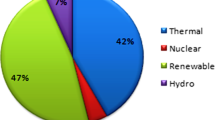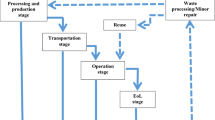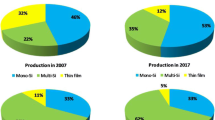Abstract
The distributed energy system has achieved significant attention in respect of its application for single-building cooling and heating. Researching on the life cycle environmental impact of distributed energy systems (DES) is of great significance to encourage and guide the development of DES in China. However, the environmental performance of distributed energy systems in a building cooling and heating has not yet been carefully analyzed. In this study, based on the standards of ISO14040-2006 and ISO14044-2006, a life-cycle assessment (LCA) of a DES was conducted to quantify its environmental impact and a conventional energy system (CES) was used as the benchmark. GaBi 8 software was used for the LCA. And the Centre of Environmental Science (CML) method and Eco-indicator 99 (EI 99) method were used for environmental impact assessment of midpoint and endpoint levels respectively. The results indicated that the DES showed a better life-cycle performance in the usage phase compared to the CES. The life-cycle performance of the DES was better than that of the CES both at the midpoint and endpoint levels in view of the whole lifespan. It is because the CES to DES indicator ratios for acidification potential, eutrophication potential, and global warming potential are 1.5, 1.5, and 1.6, respectively at the midpoint level. And about the two types of impact indicators of ecosystem quality and human health at the endpoint level, the CES and DES ratios of the other indicators are greater than 1 excepting the carcinogenicity and ozone depletion indicators. The human health threat for the DES was mainly caused by energy consumption during the usage phase. A sensitivity analysis showed that the climate change and inhalable inorganic matter varied by 1.3% and 6.1% as the electricity increased by 10%. When the natural gas increased by 10%, the climate change and inhalable inorganic matter increased by 6.3% and 3.4%, respectively. The human health threat and environmental damage caused by the DES could be significantly reduced by the optimization of natural gas and electricity consumption.
摘要
分布式能源系统在单栋建筑制冷供热方面的应用受到高度重视,研究分布式能源系统的生命周期环境影响,对鼓励和引导中国分布式能源系统的发展具有重要意义。然而,关于分布式能源系统在建筑制冷供热过程中的环境性能全面分析的研究较少。本研究基于ISO14040-2006 和ISO14044-2006 标准,对分布式能源系统(DES)进行生命周期评价(LCA),以常规能源系统(CES)为基准,量化其环境影响。采用GaBi 8 软件进行生命周期评价。采用环境科学中心(CML)法和生态指数99(EI 99)法分别进行中点水平和终点水平的环境影响评价。结果表明:与CES 相比,DES 在使用阶段表现出更好的生命周期性能; 在中点水平上,酸化潜力、富营养化潜力和全球变暖潜力的CES 与DES 指标比值分别为1.5、1.5 和1.6,终点水平的生态系统质量和人类健康两类影响指标中,除致癌性和臭氧消耗指标外,CES和DES 其他指标的比值均大于1,即从整个生命周期来看,DES 的生命周期性能在中点和端点水平均优于CES; DES 对人体健康的威胁主要是由于使用阶段的能源消耗造成的。敏感性分析表明,当电量增加10% 时,气候变化和可吸入无机物变化幅度分别为1.3% 和6.1%; 当天然气增加10% 时,气候变化和可吸入无机物分别增加6.3% 和3.4%; 通过天然气和电耗的优化,可以显著降低DES 造成的人类健康威胁和环境破坏。
Similar content being viewed by others
References
Center TUBER. 2017 Annual report on China building energy efficiency [M]. Beijing: China Architecture & Building Press, 2018. (in Chinese)
WANG Jiang-jiang, YANG Ying, MAO Tian-zhi, et al. Life cycle assessment (LCA) optimization of solar-assisted hybrid CCHP system [J]. Applied Energy, 2015, 146: 38–52. DOI: https://doi.org/10.1016/j.apenergy.2015.02.056.
SOMMA M D, YAN B, BIANCO N, et al Multi-objective design optimization of distributed energy systems through cost and exergy assessments [J]. Applied Energy, 2017, 204: 1299–1316. DOI: https://doi.org/10.1016/j.apenergy.2017.03.105.
JING You-yin, BAI He, WANG Jiang-jiang, et al. Life cycle assessment of a solar combined cooling heating and power system in different operation strategies [J]. Applied Energy, 2012, 92: 843–853. DOI: https://doi.org/10.1016/j.apenergy.2011.08.046.
AL-SULAIMAN F A, HAMDULLAHPUR F, DINCER I. Performance assessment of a novel system using parabolic trough solar collectors for combined cooling, heating, and power production [J]. Renewable Energy, 2012, 48: 161–172. DOI: https://doi.org/10.1016/j.renene.2012.04.034.
RAD F M, FUNG A S, LEONG W H. Feasibility of combined solar thermal and ground source heat pump systems in cold climate, Canada [J]. Energy and Buildings, 2013, 61: 224–232. DOI: https://doi.org/10.1016/j.enbuild.2013.02.036.
LIU Tai-xiu, LIU Qi-bin, LEI Jing, et al. Solar-clean fuel distributed energy system with solar thermochemistry and chemical recuperation [J]. Applied Energy, 2018, 225: 380–391. DOI: https://doi.org/10.1016/j.apenergy.2018.04.133.
FANI M, SADREDDIN A. Solar assisted CCHP system, energetic, economic and environmental analysis, case study: Educational office buildings [J]. Energy and Buildings, 2017, 136: 100–109. DOI: https://doi.org/10.1016/j.enbuild.2016.11.052.
LIU Tai-xiu, LIU Qi-bin, DA Xu, et al. Performance investigation of a new distributed energy system integrated a solar thermochemical process with chemical recuperation [J]. Applied Thermal Engineering, 2017, 119: 387–395. DOI: https://doi.org/10.1016/j.applthermaleng.2017.03.073.
YILMAZ F. Thermodynamic performance evaluation of a novel solar energy based multigeneration system [J]. Applied Thermal Engineering, 2018, 143: 429–437. DOI: https://doi.org/10.1016/j.applthermaleng.2018.07.125.
ZOGOU O, STAMATELOS A. Optimization of thermal performance of a building with ground source heat pump system [J]. Energy Conversion and Management, 2007, 48(11): 2853–2863. DOI: https://doi.org/10.1016/j.enconman.2007.07.012.
WANG En-yu, FUNG A S, QI Cheng-ying, et al. Performance prediction of a hybrid solar ground-source heat pump system [J]. Energy and Buildings, 2012, 47: 600–611. DOI: https://doi.org/10.1016/j.enbuild.2011.12.035.
OZGENER O, HEPBASLI A. A review on the energy and exergy analysis of solar assisted heat pump systems [J]. Renewable and Sustainable Energy Reviews, 2007, 11(3): 482–496. DOI: https://doi.org/10.1016/j.rser.2004.12.010.
OZGENER O, HEPBASLI A. Modeling and performance evaluation of ground source (geothermal) heat pump systems [J]. Energy and Buildings, 2007, 39(1): 66–75. DOI: https://doi.org/10.1016/j.enbuild.2006.04.019.
KJELLSSON E, HELLSTRÖM G, PERERS B. Optimization of systems with the combination of ground-source heat pump and solar collectors in dwellings [J]. Energy, 2010, 35(6): 2667–2673. DOI: https://doi.org/10.1016/j.energy.2009.04.011.
CHAPUIS S, BERNIER M. Seasonal storage of solar energy in borehole heat exchangers [C]//11th Int. IBPSA Conf. Glasgow, Scotland, 2009J: 599–606. http://www.ibpsa.org/proceedings/BS2009/BS09_0599_606.pdf.
OZGENER O. Use of solar assisted geothermal heat pump and small wind turbine systems for heating agricultural and residential buildings [J]. Energy, 2010, 35(1): 262–268. DOI: https://doi.org/10.1016/j.energy.2009.09.018.
YUAN Jia-qi, XIAO Zi-wei, ZHANG Chong, et al. A control strategy for distributed energy system considering the state of thermal energy storage [J]. Sustainable Cities and Society, 2020, 63: 102492. DOI: https://doi.org/10.1016/j.scs.2020.102492.
THIBODEAU C, BATAILLE A, SIÉ M. Building rehabilitation life cycle assessment methodology-state of the art [J]. Renewable and Sustainable Energy Reviews, 2019, 103: 408–422. DOI: https://doi.org/10.1016/j.rser.2018.12.037.
JING You-yin, BAI He, WANG Jiang-jiang. Multi-objective optimization design and operation strategy analysis of BCHP system based on life cycle assessment [J]. Energy, 2012, 37(1): 405–416. DOI: https://doi.org/10.1016/j.energy.2011.11.014.
ZHANG Di, EVANGELISTI S, LETTIERI P, et al. Optimal design of CHP-based microgrids: Multiobjective optimisation and life cycle assessment [J]. Energy, 2015, 85: 181–193. DOI: https://doi.org/10.1016/j.energy.2015.03.036.
ANASTASELOS D, OXIZIDIS S, MANOUDIS A, et al. Environmental performance of energy systems of residential buildings: Toward sustainable communities [J]. Sustainable Cities and Society, 2016, 20: 96–108. DOI: https://doi.org/10.1016/j.scs.2015.10.006.
OREGI X, HERNANDEZ P, HERNANDEZ R. Analysis of life-cycle boundaries for environmental and economic assessment of building energy refurbishment projects [J]. Energy and Buildings, 2017, 136: 12–25. DOI: https://doi.org/10.1016/j.enbuild.2016.11.057.
MOSLEHI S, REDDY T A. An LCA methodology to assess location-specific environmental externalities of integrated energy systems [J]. Sustainable Cities and Society, 2019, 46: 101425. DOI: https://doi.org/10.1016/j.scs.2019.101425.
ALBERTÍ J, RAIGOSA J, RAUGEI M, et al. Life cycle assessment of a solar thermal system in Spain, eco-design alternatives and derived climate change scenarios at Spanish and Chinese national levels [J]. Sustainable Cities and Society, 2019, 47: 101467. DOI: https://doi.org/10.1016/j.scs.2019.101467.
HAJARE A, ELWAKIL E. Integration of life cycle cost analysis and energy simulation for building energy-efficient strategies assessment [J]. Sustainable Cities and Society, 2020, 61: 102293. DOI: https://doi.org/10.1016/j.scs.2020.102293.
BRUSSEAU M L. Sustainable development and other solutions to pollution and global change [M]//Environmental and Pollution Science. Amsterdam: Elsevier, 2019: 585–603. DOI: https://doi.org/10.1016/b978-0-12-814719-1.00032-x.
ISO14040. Environmental management-life cycle assessment-principles and framework [S]. 2006.
ISO14044. Environmental management-life cycle assessments-requirements and guidelines [S]. 2006.
Think step. GaBi 8 software and databases [M]. Germany: Leinfelden-Echterdingen, 2018.
YU Sui-ran, TAO Jing. Product life cycle design and evaluation [M]. Beijing: Science Press, 2012. (in Chinese)
GUINEE J B. Handbook on life cycle assessment operational guide to the ISO standards [J]. The International Journal of Life Cycle Assessment, 2002, 7(5): 311–313. DOI: https://doi.org/10.1007/BF02978897.
POHL J, HILTY L M, FINKBEINER M. How LCA contributes to the environmental assessment of higher order effects of ICT application: A review of different approaches [J]. Journal of Cleaner Production, 2019, 219: 698–712. DOI: https://doi.org/10.1016/j.jclepro.2019.02.018.
GOEDKOOP M, SPRIENSMA R. The ecoindicator-99, a damage oriented method for life cycle impact assessment; reportmethodology, amersfoort, pré consultants [R]. Vrom Zoetermeer, 2000.
HOFSTETTER P. Perspective in life cycle impact assessment: A structured approach to combine of the technosphere, ecosphere and valuesphere [J]. The International Journal of Life Cycle Assessment, 2000, 5(1): 58. DOI: https://doi.org/10.1007/BF02978561.
LIU Xin, YUAN Zeng-wei. Life cycle environmental performance of by-product coke production in China [J]. Journal of Cleaner Production, 2016, 112: 1292–1301. DOI: https://doi.org/10.1016/j.jclepro.2014.12.102.
ALEJANDRE E M, van BODEGOM P M, GUINÉE J B. Towards an optimal coverage of ecosystem services in LCA [J]. Journal of Cleaner Production, 2019, 231: 714–722. DOI: https://doi.org/10.1016/j.jclepro.2019.05.284.
LUAN Zhong-quan. Environmental attributes assessment of product green design and its application based on the eco-indicator 99 [J]. Light Industry Machinery, 2004(2): 8–11. (in Chinese)
FINNVEDEN G, HAUSCHILD M Z, EKVALL T, et al. Recent developments in life cycle assessment [J]. Journal of Environmental Management, 2009, 91(1): 1–21. DOI: https://doi.org/10.1016/j.jenvman.2009.06.018.
HUISMAN J. The QWERTY/EE concept, quantifying recyclability and eco-efficiency for end-of-life treatment of consumer electronic products [M]//Design Engineering & Production. 2003. https://www.researchgate.net/publication/27346227.
Author information
Authors and Affiliations
Contributions
The overarching research goals were developed by LIU Chang-rong, WANG Han-qing, and YANG Sheng. LIU Chang-rong and TANG Yifang provided the life-cycle inventory of the system, and analyzed the data. LI Chao-jun and JIN Wenting established the system LCA models. LIU Chang-rong, TANG Yi-fang and YANG Sheng analyzed the LCI results. The initial draft of the manuscript was written by LIU Zhi-qiang, LIU Chang-rong, and TANG Yi-fang. All authors replied to reviewers’ comments and revised the final version.
Corresponding author
Additional information
Conflict of interest
The authors declare that they have no known competing financial interests or personal relationships that could have appeared to influence the work reported in this paper.
Foundation item: Projects(51676209, 22008265) supported by the National Natural Science Foundation of China; Projects(2020JJ6072, 2021JJ50007) supported by the Hunan Province Natural Science Foundation, China
Rights and permissions
About this article
Cite this article
Liu, Cr., Tang, Yf., Wang, Hq. et al. Comparison of life cycle performance of distributed energy system and conventional energy system for district heating and cooling in China. J. Cent. South Univ. 29, 2357–2376 (2022). https://doi.org/10.1007/s11771-022-5073-y
Received:
Accepted:
Published:
Issue Date:
DOI: https://doi.org/10.1007/s11771-022-5073-y
Key words
- life-cycle assessment
- distributed energy system
- conventional energy system
- building cooling and heating
- environmental impact




